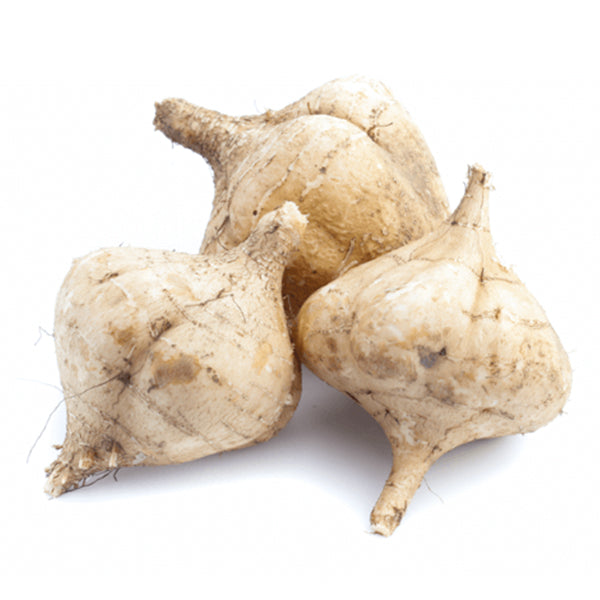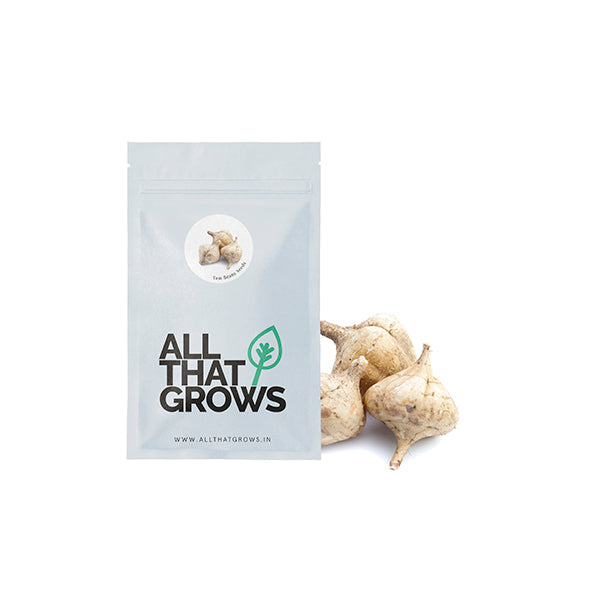



- SOWING
TIMEFebruary to April
- Sowing
DistanceLine to Line - 7 to 10 inches, Plant to Plant - 25 to 35 inches
- Fruit
WeightN/A
- Fruit
ShapeOval shaped root tuber
- Days to
maturity140 to 160 days after germination
- Details
- How to sow
- Reviews
A native of Mexico and South America, yam beans or jicama are not completely unknown in kitchens around the world. Jicama is a root vegetable from the legumes family of plants. The texture of the jicama flesh is somewhat similar to a potato with more water content and tastes slightly sweet. Tropical and warm areas are best to grow this voluminous vegetable that can be a great addition to your recipes. Jicama can be eaten raw or cooked. The seed pods, seeds, leaves, flowers and stems of the plant that are above the soil surface are not edible and must not be consumed. Jicama is also relatively low in calories and can be generously added to your salads and stir-fries. Growing jicama plants will take a long time before the tubers are ready to be harvested. Usually, it takes about 140 to 160 days to fully form the desirable root size.
Planting instructions
Jicama, unlike potatoes, can not be grown from tubers and must be started from seeds. You can either start Jicama seeds indoors or directly plant them outdoors with some staking in place to support the climbing vines. Sow the large seeds at a depth of 1.5 to 2 inch in a rich, moist and loamy soil bed. You also try soaking the seeds overnight in warm water to accelerate the germination process. It’s best not to plant Jicama plants with Potatoes and Tomatoes.
Growing Requirements
pests & diseases
Bacterial blight and fungal diseases are the most prevalent enemies of Jicama plants which can be easily managed with regular check-ups and organic control methods like neem oil and castor oil.
soil
Rich, moist and loamy soil with good drainage is ideal for growing Jicama.
spot
Choose a sunny spot with 5-6 hours of direct sunlight for healthy tubers.
temperature
The optimum soil temperature for germination of Jicama seeds ranges between 20 to 30 ℃
watering
Jicama requires plenty of water to grow healthy tubers. Do not let the soil dry out.
how to harvest
Just like tubers like potatoes, Jicama can be harvested once the foliage starts turning slightly brown above the soil. The tubers will reach a diameter of 5-7 inches and can be dug up for consumption at that stage.
Avoid washing the Jicama tubers if you plan on storing them after harvesting. Jicama will pair well with celery, carrots and apples once the skin is removed.

Customer Reviews
The productiveness of any seed we sell is subject to your local climatic conditions*, the sowing method you adopt, and your commitment to the planting process. We give no warranty, expressed or implied, and are in no way responsible for the produce.
Please note that all our seasonal recommendations/ sowing information is as per the local climatic conditions. *For more information on the optimum conditions required for growing seeds in your region, please contact us at, hello@allthatgrows.in or Whatsapp us at, +91 8544865077
Questions & Answers
Have a Question?
Be the first to ask a question about this.




Yam Bean Seeds
Seed Type : Non-Hybrid, Open Pollinated and Non-GMO
PLANT TYPE : Climbing legume vines
SOWING TIME : February to April
FRUIT : Oval-shaped root tubers
DAYS TO MATURITY : 140 to 160 days after germination
A native of Mexico and South America, yam beans or jicama are not completely unknown in kitchens around the world. Jicama is a root vegetable from the legumes family of plants. The texture of the jicama flesh is somewhat similar to a potato with more water content and tastes slightly sweet. Tropical and warm areas are best to grow this voluminous vegetable that can be a great addition to your recipes. Jicama can be eaten raw or cooked. The seed pods, seeds, leaves, flowers and stems of the plant that are above the soil surface are not edible and must not be consumed. Jicama is also relatively low in calories and can be generously added to your salads and stir-fries. Growing jicama plants will take a long time before the tubers are ready to be harvested. Usually, it takes about 140 to 160 days to fully form the desirable root size.
Seed Type : Non-Hybrid, Open Pollinated and Non-GMO
PLANT TYPE : Climbing legume vines
SOWING TIME : February to April
FRUIT : Oval-shaped root tubers
DAYS TO MATURITY : 140 to 160 days after germination
- SOWING
TIMEFebruary to April
- Sowing
DistanceLine to Line - 7 to 10 inches, Plant to Plant - 25 to 35 inches
- Fruit
WeightN/A
- Fruit
ShapeOval shaped root tuber
- Days to
maturity140 to 160 days after germination
Planting instructions
Jicama, unlike potatoes, can not be grown from tubers and must be started from seeds. You can either start Jicama seeds indoors or directly plant them outdoors with some staking in place to support the climbing vines. Sow the large seeds at a depth of 1.5 to 2 inch in a rich, moist and loamy soil bed. You also try soaking the seeds overnight in warm water to accelerate the germination process. It’s best not to plant Jicama plants with Potatoes and Tomatoes.
Growing Requirements
pests & diseases
Bacterial blight and fungal diseases are the most prevalent enemies of Jicama plants which can be easily managed with regular check-ups and organic control methods like neem oil and castor oil.
soil
Rich, moist and loamy soil with good drainage is ideal for growing Jicama.
spot
Choose a sunny spot with 5-6 hours of direct sunlight for healthy tubers.
temperature
The optimum soil temperature for germination of Jicama seeds ranges between 20 to 30 ℃
watering
Jicama requires plenty of water to grow healthy tubers. Do not let the soil dry out.
how to harvest
Just like tubers like potatoes, Jicama can be harvested once the foliage starts turning slightly brown above the soil. The tubers will reach a diameter of 5-7 inches and can be dug up for consumption at that stage.
Avoid washing the Jicama tubers if you plan on storing them after harvesting. Jicama will pair well with celery, carrots and apples once the skin is removed.



 Sign In
Sign In








